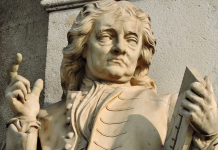Ayn1 Rand was born on February 2, 1905, in the city of Saint Petersburg, Russia2 and died on March 6, 1983, in New York, USA3. “Ayn Rand” was not her birth name; her birth name was Alice Rosenbaum.4 She adopted the name “Ayn” from a Finish writer and “Rand” shortly after arriving in America from her Remington-Rand typewriter5. Rand decided to become an author at the age of nine and “everything [she had] done” was directed towards that goal. Rand attended college in Europe, where she took history as her major subject and philosophy as her “special interest.” The first she took “in order to have a factual knowledge of men’s past, for [her] future writing” and the second “in order to achieve an objective definition of [her] values”6.
Though born in Russia and educated in Europe Rand considered herself an American “by choice and conviction” and came to America in 1926 based on her moral premises; believing it to be “the only country where one could be fully free to write.” She came alone and found the transition difficult at first, having to take odd jobs to earn a living until she could make a financial success with her writing7. She achieved this with the publication of her second novel The Fountainhead in 1943 which brought her international fame and even more so with the publication of Atlas Shrugged in 1957. With this, her “position in history”, both as a novelist and as a philosopher, was established8.
Rand met Frank (Charles Francis) O’Conner on a movie set in Hollywood shortly after her move to America9. At the time she was interested in writing screen-plays10 for silent films11. He was eight years her senior, born September 22, 1897, in Lorain, Ohio. He was “drawn to motion pictures ever since the first two-reelers came to Lorain”12. They were married in 1929 and remained so until his death fifty years later13. Rand saw O’Conner as the physical ideal for a man and portrayed this in all her novels. He was not, however, her intellectual ideal14, Rand sought this elsewhere.
Their marriage was not faithful in the traditional sense, however, as she and Nathaniel Branden15 (who was also married at the time) engaged in an intimate and romantic affair, which Branden insists Rand initiated and wished to maintain.16 Both were intent on preserving their current marriages and both Rand’s husband, O’Conner and Branden’s wife, Barbara Branden were fully aware of the relationship and professed to agree with the conditions they presented17. Rand and Branden (who was her intellectual ideal and was asked to inherit her property and become her “intellectual heir”) were in love, but all held that it was best if they kept this secret from their group of friends (“The Collective”) and associates. Rand dedicated Atlas Shrugged, her most influential novel to him declaring that he was her legal and “intellectual heir” and “proclaimed him to be an ideal exponent of her philosophy”18. Eventually, however, Branden lost interest in Rand romantically, though he remained “obsessed” with her intellectually, and sought to break off the relationship. Knowing how this would affect Rand, he wrote her a letter describing why it was “rational” that they terminate their relationship of several years. The letter was not well received19.
Rand went to Barbara Branden for support; raving about the letter and altogether not accepting what was happening, condemning Branden at every turn. (The Brandens had split up months before, though were still on amicable terms. Barbara knew of the letter and had proof read it for Branden, though she professed to Rand that she was not aware of it.) Rand sought to destroy him professionally, though could not logically do so without making their affair publicly known (which she was not willing to do), but nonetheless sought to destroy him as well as she could20. In the 1968 May issue of The Objectivist Newsletter Rand wrote an article titled “To Whom It May Concern” which was six pages long. The following is an excerpt:
This is to inform my readers and all those interested in Objectivism that Nathaniel Branden and Barbara Branden are no longer associated with this magazine, with me or with my philosophy.
I have permanently broken all personal, professional and business association with them, and have withdrawn from them the permission to use my name in connection with their commercial, professional, intellectual or other activities.
I hereby withdraw my endorsement of them and of their future works and activities. I repudiate both of them, totally and permanently, as spokesman for or of Objectivism.2122.
Rand later declared Leonard Peikoff as her legal and “intellectual heir” and to this date he remains the representative of her Objectivism and of her works and owns their copyrights. (ibid, 364.))
Works Cited:
- “Ayn Rand – About Her Life.” The Ayn Rand Institute. 1999. http://www.aynrand.com/aynrand. (4 October 2000).
- Branden, Barbra and Nathaniel. “In Answer to Rand: Preface.” Nathenial Branden. http://www.nathanielbranden.net/ayn/ayn05.shtml. (10 October 2000).
- Branden, Nathaniel. My Years with Ayn Rand. San Francisco: Jossey-Bass Publishers, 1999.
- Rand, Ayn. Atlas Shrugged. New York: Signet, 1957.
- Rand, Ayn. The Fountainhead. New York: Signet, 1952.
- Rhymes with “mine”. [↩]
- Nathaniel Branden, My Years with Ayn Rand, by Nathaniel Branden (hereafter shortened to “MYAR”), 61. [↩]
- ibid, 403 [↩]
- Rand maintained that she would never tell anyone her original family name as she still had relatives living in Russia who she felt would be endangered if their relation was discovered due to the controversial issues which she wrote about (MYAR, 61). [↩]
- ibid, 61. [↩]
- Ayn Rand, Atlas Shrugged, 1075. [↩]
- Rand, Atlas Shrugged, 1075. [↩]
- Pamphlet, “Ayn Rand – About Her Life”. [↩]
- MYAR, 61 [↩]
- ibid, 57. [↩]
- ibid, 61 [↩]
- ibid, 57 [↩]
- Ayn Rand, The Fountainhead, 708 [↩]
- MYAR, 57 [↩]
- Nathaniel Brandon’s original name was Nathan Blumenthal, which he had disliked for a long time, but was intent on keeping the initials. In September of 1954, he had his name legally changed to reflect a name that felt “more like [himself]”. His wife, Barbara, also adopted the name change (MYAR, 118). [↩]
- Rand later declared that no such relationship had ever taken place, though now it seems publicly accepted that such an affair did take place (MYAR, 361). [↩]
- MYAR, 135. [↩]
- ibid, 226 [↩]
- ibid, 332 [↩]
- MYAR, 333-364 [↩]
- ibid, 61 [↩]
- Nathaniel and Barbara Brandon together wrote a response letter to Rand’s accusations about the nature of their break, which was sent out to all subscribers of The Objectivist Newsletter. For further reading, the complete response can be found online: http://www.nathanielbranden.net/ayn/ayn05.shtml (Branden, Barbara and Nathaniel, “In Answer to Ayn Rand: Preface” [↩]








